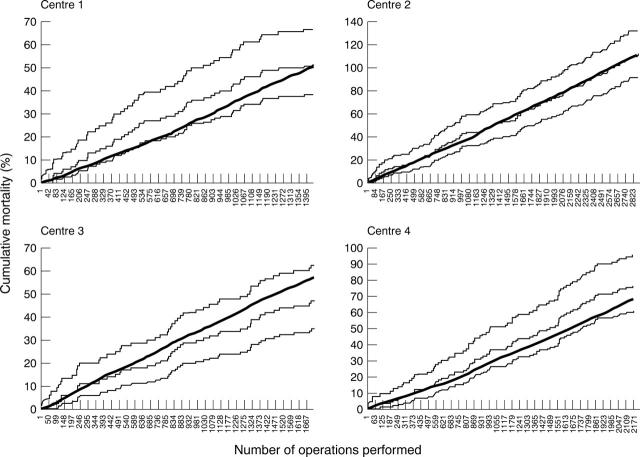Abstract
OBJECTIVE—To study the use of the Parsonnet score to predict mortality following adult cardiac surgery. DESIGN—Prospective study. SETTING—All centres performing adult cardiac surgery in the north west of England. SUBJECTS—8210 patients undergoing surgery between April 1997 and March 1999. MAIN OUTCOME MEASURES—Risk factors and in-hospital mortality were recorded according to agreed definitions. Ten per cent of cases from each centre were selected at random for validation. A Parsonnet score was derived for each patient and its predictive ability was studied. RESULTS—Data collection was complete. The operative mortality was 3.5% (95% confidence interval 3.1% to 3.9%), ranging from 2.7% to 3.8% across the centres. On validation, the incidence of discrepancies ranged from 0% to 13% for the different risk factors. The predictive ability of the Parsonnet score measured by area under the receiver operating characteristic curve was 0.74. The mean Parsonnet score for the region was 7.0, giving an observed to expected mortality ratio of 0.51 (range 0.4 to 0.64 across the centres). A new predictive model was derived from the data by multivariate analysis which includes nine objective risk factors, all with a significant association with mortality, which highlights some of the deficits of the Parsonnet score. CONCLUSIONS—Risk stratified mortality data were collected on 100% of patients undergoing adult cardiac surgery in two years within a defined geographical region and were used to set an audit standard. Problems with the Parsonnet score of subjectivity, inclusion of many items not associated with mortality, and the overprediction of mortality have been highlighted. Keywords: risk stratification; cardiac surgery; Parsonnet score; audit
Full Text
The Full Text of this article is available as a PDF (176.9 KB).
Figure 1 .
Cumulative mortality with 95% confidence interval (CI) and cumulative predicted mortality by centre. The two thin outlying lines represent 95% CIs around cumulative observed mortality (central thin line), and the thick line represents cumulative predictive mortality working to 0.51 of the Parsonnet score. Performances deviating significantly can be seen by predicted mortality lying either consistently above (better than expected performance) or below (worse than expected performance) the 95% CIs of observed mortality. This was not the case for any of the centres.
Selected References
These references are in PubMed. This may not be the complete list of references from this article.
- Allan A., Forsyth A. T. Risk stratification for open heart surgery. BMJ. 1992 Dec 12;305(6867):1500–1501. doi: 10.1136/bmj.305.6867.1500-c. [DOI] [PMC free article] [PubMed] [Google Scholar]
- Bridgewater B., Neve H., Moat N., Hooper T., Jones M. Predicting operative risk for coronary artery surgery in the United Kingdom: a comparison of various risk prediction algorithms. Heart. 1998 Apr;79(4):350–355. doi: 10.1136/hrt.79.4.350. [DOI] [PMC free article] [PubMed] [Google Scholar]
- Dubois R. W., Rogers W. H., Moxley J. H., 3rd, Draper D., Brook R. H. Hospital inpatient mortality. Is it a predictor of quality? N Engl J Med. 1987 Dec 24;317(26):1674–1680. doi: 10.1056/NEJM198712243172626. [DOI] [PubMed] [Google Scholar]
- Dupuis J. Y., Wynands J. E. Risk-adjusted mortality to assess quality of care in cardiac surgery. Can J Anaesth. 1993 Feb;40(2):91–97. doi: 10.1007/BF03011303. [DOI] [PubMed] [Google Scholar]
- Keogh B. E., Dussek J., Watson D., Magee P., Wheatley D. Public confidence and cardiac surgical outcome. Cardiac surgery: the fall guy in medical quality assurance. BMJ. 1998 Jun 13;316(7147):1759–1760. doi: 10.1136/bmj.316.7147.1759. [DOI] [PMC free article] [PubMed] [Google Scholar]
- Marshall G., Shroyer A. L., Grover F. L., Hammermeister K. E. Bayesian-logit model for risk assessment in coronary artery bypass grafting. Ann Thorac Surg. 1994 Jun;57(6):1492–1500. doi: 10.1016/0003-4975(94)90107-4. [DOI] [PubMed] [Google Scholar]
- Nashef S. A., Carey F., Silcock M. M., Oommen P. K., Levy R. D., Jones M. T. Risk stratification for open heart surgery: trial of the Parsonnet system in a British hospital. BMJ. 1992 Oct 31;305(6861):1066–1067. doi: 10.1136/bmj.305.6861.1066. [DOI] [PMC free article] [PubMed] [Google Scholar]
- O'Connor G. T., Plume S. K., Olmstead E. M., Coffin L. H., Morton J. R., Maloney C. T., Nowicki E. R., Levy D. G., Tryzelaar J. F., Hernandez F. Multivariate prediction of in-hospital mortality associated with coronary artery bypass graft surgery. Northern New England Cardiovascular Disease Study Group. Circulation. 1992 Jun;85(6):2110–2118. doi: 10.1161/01.cir.85.6.2110. [DOI] [PubMed] [Google Scholar]
- O'Connor G. T., Plume S. K., Olmstead E. M., Morton J. R., Maloney C. T., Nugent W. C., Hernandez F., Jr, Clough R., Leavitt B. J., Coffin L. H. A regional intervention to improve the hospital mortality associated with coronary artery bypass graft surgery. The Northern New England Cardiovascular Disease Study Group. JAMA. 1996 Mar 20;275(11):841–846. [PubMed] [Google Scholar]
- Poloniecki J., Valencia O., Littlejohns P. Cumulative risk adjusted mortality chart for detecting changes in death rate: observational study of heart surgery. BMJ. 1998 Jun 6;316(7146):1697–1700. doi: 10.1136/bmj.316.7146.1697. [DOI] [PMC free article] [PubMed] [Google Scholar]
- Spiegelhalter D. J. Risk stratification for open heart surgery. BMJ. 1992 Dec 12;305(6867):1500–1500. doi: 10.1136/bmj.305.6867.1500-a. [DOI] [PMC free article] [PubMed] [Google Scholar]
- Swets J. A. Measuring the accuracy of diagnostic systems. Science. 1988 Jun 3;240(4857):1285–1293. doi: 10.1126/science.3287615. [DOI] [PubMed] [Google Scholar]
- Treasure T. Lessons from the Bristol case. More openness--on risks and on individual surgeons' performance. BMJ. 1998 Jun 6;316(7146):1685–1686. [PMC free article] [PubMed] [Google Scholar]
- Treasure T. Risks and results of surgery. Br Heart J. 1995 Jul;74(1):11–12. doi: 10.1136/hrt.74.1.11. [DOI] [PMC free article] [PubMed] [Google Scholar]
- de Leval M. R., François K., Bull C., Brawn W., Spiegelhalter D. Analysis of a cluster of surgical failures. Application to a series of neonatal arterial switch operations. J Thorac Cardiovasc Surg. 1994 Mar;107(3):914–924. [PubMed] [Google Scholar]



